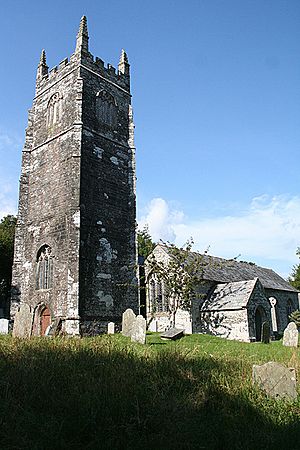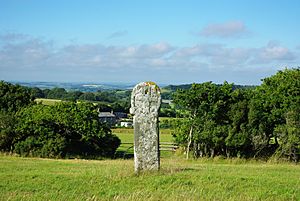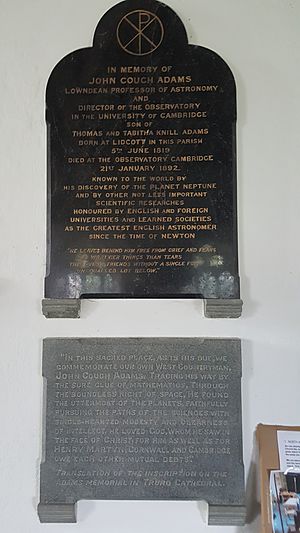Laneast facts for kids
Quick facts for kids Laneast
|
|
|---|---|
| Lua error in Module:Location_map at line 530: Unable to find the specified location map definition: "Module:Location map/data/Cornwall (mainland)" does not exist. | |
| Population | 209 (Civil Parish, 2011) |
| OS grid reference | SX228841 |
| Civil parish |
|
| Unitary authority | |
| Ceremonial county | |
| Region | |
| Country | England |
| Sovereign state | United Kingdom |
| Post town | LAUNCESTON |
| Postcode district | PL15 |
| Dialling code | 01566 |
| Police | Devon and Cornwall |
| Fire | Cornwall |
| Ambulance | South Western |
| EU Parliament | South West England |
| UK Parliament |
|
Laneast (Cornish: Lanneyst) is a small village and civil parish in Cornwall, England. It sits above the River Inny valley, about 11 kilometers (6 miles) west of Launceston. In 2011, about 209 people lived here.
Contents
Laneast Parish Church
The main church in Laneast is dedicated to Saint Sidwell and Saint Gulval, or sometimes to St Michael. The church and its graveyard were officially opened by Bishop Edmund Lacy in 1436. Before this time, people from Laneast were buried at the main church of St Stephen's.
Church History and Features
The original church was built in a cross shape during the Norman period. More parts were added in the 1200s and 1300s. In the 1400s, the south aisle (a side section) and the tower were finished. The church was decorated with beautiful wooden carvings and stained glass windows.
Even though the church was repaired a lot in 1848, many of its old wooden features and stained glass from the late Middle Ages are still there today.
Jordan Well
In a field across from the church, you can find the holy 'Jordan Well'. This well was once used for telling the future and, until quite recently, for baptisms (a Christian ceremony).
Churchyard Cross
In the churchyard, there is a special Cornish cross with four holes. It was discovered buried in the churchyard in 1952. The bottom part of the cross and its base were rebuilt in 1954.
Laneast Down Cross
Another Cornish cross stands on Laneast Down. It is unique because it is made from Polyphant stone instead of the usual granite. The two sides of its top part are oval-shaped and have Latin crosses carved into them.
Lidcott Mine
To the northeast of Laneast is Lidcott Mine. This was a surface mine from the 1800s, where workers dug for manganese. Manganese is a metal used in making steel and batteries.
Today, Lidcott Mine is a Site of Special Scientific Interest (SSSI). This means it is a protected area because of its important geological features.
Famous People from Laneast
Laneast is known as the birthplace of some notable individuals:
- John Couch Adams: A famous mathematician and astronomer. He is known for discovering the planet Neptune.
- William Grylls Adams: A physicist and professor of Natural Philosophy at King's College, London.
- Robert Burnard: A talented painter.





